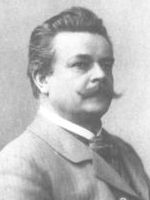August Klughardt
(November 30, 1847 – August 3, 1902/ 55세) was a German composer and conductor.
Symphony No. 3, Op. 37 (1880/ 33세)
I. Lebhaft 0:00
II. Langsam 14:49
III. Massig 22:55
IV. Munter 29:37
Anhaltische Philharmonie Dessau/Golo Berg
Symphony No. 4 (1897)
Conducted by Antony Hermus with the Anhaltische Philharmonie Dessau.
The standout movement for me is the glorious andante.
I. Allegro Non Troppo - 00:00
II. Andante Cantabile - 14:07
III. Presto - 23:59
IV. Andante maestoso - Moderato e molto maestoso - 27:59
Symphony No. 5 (1897/50세)
II. Allegro Non Troppo - 00:00
II. Adagio - 9:04
III. Allegro Vivace - Piu Moderato - Allegro Vivace - 16:47
IV. Andante - 21:41
V. Allegro Molto - 26:25
==================================================================

August Klughardt 1847-1902
August Friedrich Martin Klughardt 라는 긴 이름을 갖고있는 Klughardt 는 낭만주의 시대의 작곡가이자 지휘자이기도 하였다..Kothen에서 태어났으며, 10살무렵 피아노와 음악이론에 대하여 렛슨을 받음으로서 음악적인 트레이닝을 시작하였다..얼마지 않아 곧 자신의 첫번 째 작품을 작곡할 수 있었는데, 재학중이던 학교에서 자신 스스로 창단한 음악 서클을 통해 이 작품을 초연하였다..1863년 가족과 함께 Dessau로 삶의 터전을 옮겼으며 피아니스트로서 음악계에 데뷔하였다. 학교를 졸업한 후 1866년 활동 무대를 드레스덴으로 옮겼으며 더욱 심도있는 렛슨을 받았으며, 아울러 자신의 작품을 대중들에게 선보일 수 있게되었다..
한 해 뒤 그는 작곡가로서의 자신의 삶을 살기를 열망하게되었다.. 최초로 그는 Posen의 municipal theatre 에서 한 시즌 동안 일하게 되었으며, 이후 Neustrelitz 한 시즌 동안 일했고, 최종적으로 뤼벡에서 수 개월동안 지휘자로서 일했다..1869년부터 1873년 까지 바이마르의 궁정 극장 오케스트라에서 일했으며, 이곳에서 리스트를 만남으로서 자신의 창작에 대한 역량을 제고하는데 크게 영향을 받았다..1873년 Neustrelitz 로 돌아갔으며, 이곳 오케스트라에서 chief conductor로 일했으며, 1880년에는 이곳 오케스트라의 manager로 지명되기도 하였다..1876년 바이로이트 페스티발을 최초로 방문했으며, 1882년부터 자신의 삶을 마치는 날 까지 Dessau 궁정의 음악 감독으로 활동하였다..1892년과 1893년 그는 바그너의 Der Ring des Nibelungen을 지휘하였으며, 1898년 Berlin Academy of Arts 의 회원이 되었고 University of Erlangen이 수여하는 명예 박사 학위를 받는 등, 말년에 여러가지 다양한 예우를 받기도 하였다..아울러 베를린의 "Singakademie" 의 지휘를 요창받았으나 이러한 제의를 거절하였다.. Roßlau 에서 54세의 나이로 갑작스럽게 삶을 마감하였다..
Klughardt는 리스트를 만남으로써 바그너와 리스트를 중심으로 전개되었던 "Neudeutsche Schule"(신독일 악파)에 대한 음악적 열정을 키우게되었다..실제로 Klughardt의 몇몇 작품들에는 이러한 신독일 악파의 주요한 음악적인 개념들이 반영되어있다.. 그럼에도 불구하고 바그너나 리스트가 거부했던 장르들을 피하지 않고 지속적으로 추구하였다..그는 6곡의 교향곡과 상당수의 실내악 작품을 썼으며, 아울러 리스트가 주창했던 symphonic poem을 작곡한 바 있다..그러나 보다 옛스러운 스타일은 표제적인 서곡들을 다수 작곡하기도 하였다..
실제로 그의 작품들 속에는 슈만의 영향이 보다 분명하게 드러나고 반영되어있다.. 그는 이러한 서로 다른 두가지의 경향을 통합하고자 하였다..Klughardt의 오페라에는 바그너의 Leitmotif 기법을 반영하 것이지만, 바그너의 음악극 대신 옛 오페라들이 취했던 방식을 고수하고있다..몇몇 그의 작품들은 자신의 어린 시절을 반영하고 있는데, 예를 들어 그의 합창 작품인 Die Grenzberichtigung Op. 25은 1870/71년에 있었던 Franco-Prussian 전쟁에서 독일이 승리했을 때 작곡된 것이다..전체적으로 Klughardt는 스스로 보다 현대적인 경향의 음악적 트렌드에 관심을 두었음에도 불구하고 보다 보수적인 작곡가로 간주되고있다..오늘날 거의 모든 그의 작품들이 잊혀져있으며, 오늘날 오직 Violoncello concerto, Schilflieder (Reed Songs), Wind quintet 정도 만이 연주되곤 한다.
<출처> 네이버 블로거 레인트리
---------------------------------------------------------
August Klughardt (1847-1902) was born in the German town of Köthen in Saxon-Anhalt. After studying music locally, Klughardt began to earn his living by conducting. He served in several locales, including Weimar where he worked from 1869 to 1873. There, he met Franz Liszt, which was very important for his creative development. While influenced by Wagner and Liszt, Klughardt did not by any means entirely adopt the ideology of their New German School, refusing to write tone poems and instead concentrating on symphonies and chamber music. The influence of Robert Schumann, and to a lesser extent Brahms, certainly is equally important. It was his failure to whole-heartedly adopt Lisztian principals which led to his being labeled as a conservative composer. Klughardt received considerable recognition as composer and won many distinctions, but today, sadly, his music, with the exception of one or two pieces, is entirely forgotten.
Though there had been a few others before it, Robert Schumann's 1844 Piano Quintet put the genre on the map and his example was followed by Brahms, Kiel, Raff and Reinecke to name but the most prominent. Toward the end of the 19th century, the piano quintet began to go in two different directions. In the first, the genre retained the intimacy of chamber music, but in the second it veered toward symphonic style. Klughardt's Piano Quintet, composed in 1884, shows both of these tendencies. It is clear that Schumann's work, structurally though not tonally, served as an example for him. The sophisticated and extensive Lento introduction was a technique used by Schumann and others as a way setting the mood in chamber music with piano. The theme which emerges from it lends the main part of the movement, Allegro con fuoco, its impassioned, urgent character. Of particular note is the richly contrasting accompaniment, including the use of church tonal modes and a particularly striking hymn-like third theme played in octaves. The lovely Adagio which follows can be styled as a Song Without Words. The third movement, Moderato, molto espressivo, though in 6/8 time is not a scherzo but an interesting combination of a waltz which turns into something else altogether, full of excitement and forward motion. The big finale, Allegro non troppo, begins with a march-like anthem, which in part recalls the opening of the quintet. The development is altogether more lyrical and leads to the brief appearance of a second theme which quickly gives way to the opening subject,
this time performed fugally. A powerful coda brings this unjustly neglected and fine work to its close.
<출처:유튜브>
'♣ 음악 감상실 ♣ > [交響曲(Symphony)] ' 카테고리의 다른 글
| Josef Liebeskind - Symphony No. 1 in A minor, Op. 4 (0) | 2014.10.08 |
|---|---|
| Zdeněk Fibich - Symphony No. 1, 2, 3 번 (0) | 2014.10.04 |
| Paul Büttner -교향곡 1,2,3번 (0) | 2014.10.01 |
| Alexander Von Zemlinsky - 교향곡 1,2번 (0) | 2014.09.29 |
| Sir Arthur Sullivan - Symphony in E Major "Irish" (1866) (0) | 2014.09.29 |
